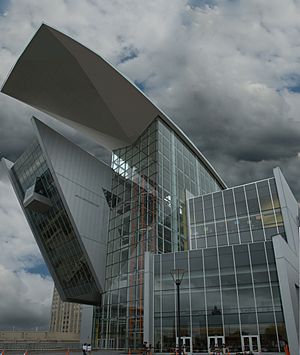Connecticut Science Center facts for kids
 |
|

Connecticut Science Center, Hartford, CT on the Riverfront
|
|
| Established | 2009 |
|---|---|
| Location | 250 Columbus Boulevard Hartford, Connecticut, United States |
| Type | Science museum |
| Public transit access | |
The Connecticut Science Center is a super cool museum with nine floors! It's located right by the Connecticut River in Hartford, Connecticut. A famous architect named César Pelli designed this amazing building, and it first opened its doors on June 12, 2009.
The whole building is really big, about 154,000 square feet! Inside, there are 40,000 square feet filled with fun, hands-on exhibits. You can watch videos, listen to sounds, see cool displays, touch things, join programs, and even watch live science shows. It's a great place to explore and learn!
Contents
Building the Science Center
How the Idea Started
Planning for the Connecticut Science Center began way back in 2001. The main goals for creating this museum were to get young people in Connecticut excited about studying science. It also aimed to help make the city of Hartford a more lively and modern place.
Funding the Project
Building a big museum like this costs a lot of money! The total cost for the Connecticut Science Center was about $165 million. The state of Connecticut helped out a lot, providing more than $100 million. The rest of the money came from generous businesses, foundations, and people who wanted to support science education.
A Green Building: Powering the Science Center
Using Clean Energy
The Connecticut Science Center is special because it's one of the first science centers to get most of its power from a special device called a fuel cell. This fuel cell is located right at the museum! Using this clean energy source was a big step for the Science Center. It helped them become a "Gold Level" LEED Certified green building. This means it's designed to be very friendly to the environment.
How the Fuel Cell Works
The fuel cell used at the Science Center is a 200-kilowatt PureCell System. It was built by a company called UTC Power. This fuel cell creates 100 percent of the electricity the Science Center needs to run! It uses natural gas but doesn't burn it. Instead, the gas goes through a special process that makes electricity, heat, and water. A small amount of carbon dioxide gas is also released, but it's much less than what traditional power plants produce.
The Maximilian E. and Marion O. Hoffman Foundation Science Theater
This theater is a fantastic place to watch science come alive! It has stadium-style seating, which means everyone gets a great view. It can hold over 200 people. The screen is huge, measuring 30 by 40 feet! The theater also has a powerful 18,000-watt Dolby sound system, so everything sounds amazing. Plus, it uses Dolby 3D technology and special glasses to make movies and presentations pop out at you!
See also


